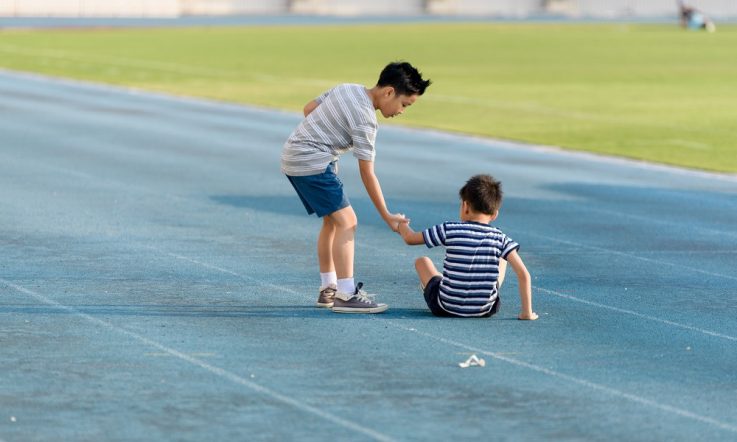There is ongoing debate about how to help young people be more resilient. There tends to be two schools of thought.
The first is that young people need to experience adversity and through this they develop resilience.
The second school of thought is that young people need to develop resilience to effectively overcome adversity. That is, if young people do not have the personal capacity to deal with adversity, they will be less likely to overcome it, now and into the future.
So, does adversity lead to resilience or does resilience lead to less adversity?
Results of our study
We recently investigated this question and published the results in a paper called Investigating the reciprocal relations between academic buoyancy and academic adversity: Evidence for the protective role of academic buoyancy in reducing academic adversity over time. We were interested to see if academic buoyancy (i.e., resilience in the academic setting) led to less academic adversity over time – or whether experiencing academic adversity would increase students' academic buoyancy.
Over the course of a year at high school, we surveyed 481 students in Years 7-12. We gathered information about students' adversities at school – such as failing a subject, not handing in most schoolwork, being suspended, moving schools, and more. We also assessed students' academic buoyancy; that is, their ability to bounce back from academic setbacks and difficulties.
We found that academically buoyant students were significantly less likely to experience academic adversity over the course of the subsequent academic year. We also found that experiencing academic adversity did not make students more buoyant.
The results from this study therefore show that it is important to boost students' academic buoyancy as an important means to reduce academic adversity down the track.
We further found that if a student did experience academic adversity, they could cope with this adversity if they already had a high level of academic buoyancy. That is, even though they experienced adversity initially, their high level of academic buoyancy meant they were well equipped to tackle future obstacles.
We concluded that academic buoyancy is an important factor in helping students manage and mitigate academic adversity. It can also act as a buffer for future adversity.
Implications of the findings
There are two practical implications from these findings: (1) reduce academic adversity where possible and (2) boost students' academic buoyancy.
To reduce academic adversity, it is important to first identify indicators of academic adversity. These will include things like chronic underachievement, learning disabilities/difficulties, peer problems, school exclusion/withdrawal, problematic transitions to a new school/context, mental health issues, etc. When these indicators are identified, vulnerable or at-risk students can be better identified.
Then the indicator for that at-risk student is to be directly addressed. For example, if it is chronic underachievement, teachers might consider load reduction instruction (Martin & Evans, 2019) that can be very helpful for struggling learners. Early identification and intervention are vital, before academic adversity and associated risks escalate too much.
Boosting academic buoyancy
To boost academic buoyancy, we have previously identified (Martin & Marsh, 2008) some key factors that practitioners can target. Here we will briefly discuss three of them: self-confidence, anxiety, and teacher-student relationships.
To help build students' self-confidence it is important to encourage them to challenge disproportionate negative thinking about themselves or their situation. It can also be helpful to encourage them to think more positively about what capacities they have and how they might use these capacities in the face of adversity. For example, they may be persistent or they may be good at help-seeking – and these can be used to help them tackle academic adversity.
There are also some straightforward strategies to help students reduce their anxiety. Good relaxation strategies can be effective. These include meditation, yoga, physical activity, and exercise.
Another strategy is to encourage students to be in ‘the here and now'. Anxiety is often fearful anticipation about the future and can involve a sense of helplessness. Grounding students in the present moment can ease their anxiety. Indeed, the present moment is often more controllable than the future and this type of thinking helps empower students. Also, be aware that some students' anxiety will require formal professional support (e.g., psychologist, doctor, etc.).
Building strong relationships
Good interpersonal relationships are frequently identified as a cornerstone of resilience. We have found much the same in schools: good teacher-student relationships are positively linked to students' academic buoyancy. Connective instruction (Martin, 2014) has been developed as an educational approach that helps teachers maintain connectedness with students in the everyday course of learning.
This approach to teaching shows how educators can connect to students on three channels: the interpersonal channel (e.g., emotionally supporting students), the content channel (e.g., delivering content that is well-matched to students' ability and interests), and the instruction channel (e.g., supporting students through load reduction instruction). The more teachers are positively connected to students, the better students are able to overcome academic adversity.
In sum, students can develop the personal attributes that help them deal with academic adversity at school – and beyond. Teachers and other educational practitioners play an important role in this.
References
Martin, A.J. (2014). Interpersonal relationships and students' academic and non-academic development: What outcomes peers, parents, and teachers do and do not impact. In D. Zandvliet., P. den Brok., T. Mainhard., & J. Tartwijk (Eds). Interpersonal relationships in education: From theory to practice. Rotterdam: Sense.
Martin, A.J., & Evans, P. (2019). Load reduction instruction: Sequencing explicit instruction and guided discovery to enhance students' motivation, engagement, learning, and achievement. In S. Tindall-Ford, S. Agostinho, & J. Sweller (Eds). Advances in Cognitive Load Theory: Rethinking teaching. New York: Routledge.
Martin, A. J., & Marsh, H.W. (2008). Academic buoyancy: Towards an understanding of students' everyday academic resilience. Journal of School Psychology, 46(1), 53-83.
Martin, A. J., & Marsh, H. W. (2019). Investigating the reciprocal relations between academic buoyancy and academic adversity: Evidence for the protective role of academic buoyancy in reducing academic adversity over time. International Journal of Behavioral Development.
The authors note that good interpersonal relationships are frequently identified as a cornerstone of resilience. As a teacher, how do you work to ensure that you’re building strong relationships with your students? Have you noticed how this impacts on their resilience?
To help build students’ self-confidence, the authors say it is important to encourage them to challenge disproportionate negative thinking about themselves or their situation. How do you achieve this in your classroom? Have you found any strategies to be particularly helpful?



